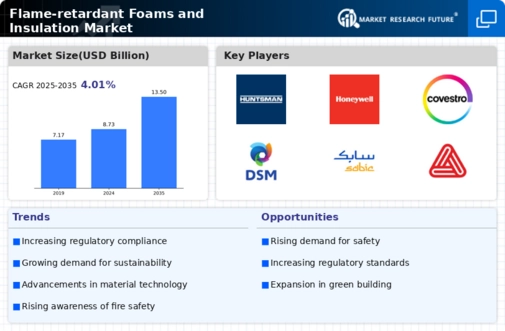Technological Innovations
Technological advancements are reshaping the Flame-retardant Foams and Insulation Market, leading to the development of more effective and efficient products. Innovations in material science have resulted in the creation of new flame-retardant formulations that offer superior performance while minimizing environmental impact. For example, the introduction of bio-based flame retardants is gaining traction, as they provide an eco-friendly alternative to traditional chemical-based options. This shift towards sustainable solutions is expected to attract a broader customer base, including environmentally conscious consumers and businesses. As technology continues to evolve, the flame-retardant foams and insulation market is likely to witness enhanced product offerings that cater to diverse applications.
Growing Construction Sector
The expansion of the construction sector plays a pivotal role in the Flame-retardant Foams and Insulation Market. With urbanization and infrastructure development on the rise, there is a heightened demand for building materials that enhance safety and energy efficiency. Flame-retardant foams and insulation are increasingly utilized in residential, commercial, and industrial construction projects to mitigate fire risks. According to industry reports, the construction sector is projected to grow at a compound annual growth rate (CAGR) of approximately 5% over the next few years. This growth is likely to bolster the demand for flame-retardant materials, as builders and architects prioritize safety and compliance with fire regulations.
Increased Awareness of Fire Safety
The heightened awareness of fire safety among consumers and industries is a driving force in the Flame-retardant Foams and Insulation Market. Recent incidents of fire-related disasters have underscored the importance of using fire-resistant materials in various applications. Consequently, there is a growing emphasis on incorporating flame-retardant foams and insulation in both new constructions and renovations. Educational campaigns and advocacy from fire safety organizations have further propelled this awareness, leading to increased demand for compliant products. As stakeholders recognize the critical role of fire safety in protecting lives and property, the flame-retardant foams and insulation market is poised for sustained growth.
Sustainability and Environmental Concerns
Sustainability concerns are increasingly influencing the Flame-retardant Foams and Insulation Market. As environmental regulations become more stringent, manufacturers are under pressure to develop flame-retardant materials that are not only effective but also environmentally friendly. The demand for sustainable building materials is on the rise, with consumers and businesses seeking products that minimize ecological impact. This trend has led to the innovation of flame-retardant foams derived from renewable resources and those that are recyclable. The market is likely to see a shift towards these sustainable options, as stakeholders prioritize eco-conscious choices in their purchasing decisions, thereby driving growth in the flame-retardant foams and insulation sector.
Regulatory Compliance and Safety Standards
The Flame-retardant Foams and Insulation Market is significantly influenced by stringent regulatory compliance and safety standards. Governments and regulatory bodies have established guidelines to ensure that materials used in construction and manufacturing meet specific fire safety criteria. This has led to an increased demand for flame-retardant foams and insulation products that comply with these regulations. For instance, the implementation of the International Building Code (IBC) has necessitated the use of fire-resistant materials in various applications. As a result, manufacturers are compelled to innovate and develop products that not only meet but exceed these safety standards, thereby driving growth in the flame-retardant foams and insulation sector.


















Leave a Comment